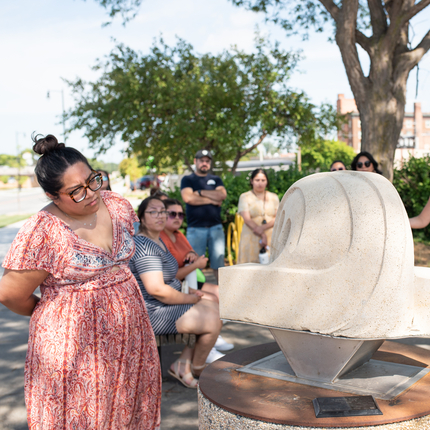Community-based and socially engaged art can help to build community, deepen understanding, and encourage empathy.
I experienced this firsthand on a recent visit to the traveling virtual reality exhibit CARNE y ARENA by artist Alejandro Iñárritu. The exhibit was in Omaha at the KANEKO earlier this year.
CARNE y ARENA (Flesh and Sand) is an immersive, full-body, virtual-reality experience that seeks to replicate the migrant experience of crossing the Mexican border into the U.S. As a visitor to the exhibit, you walk barefoot on rocky sand, feel harsh wind on your face, and experience 360-degree virtual-reality audio and video that places you alongside a group of migrants crossing and then apprehended by the Border Patrol.
The exhibit is based on interviews the artist did with Mexican and Central American refugees. The actors are the migrants themselves. Before I saw the exhibit, I did not know virtual reality could be so realistic or used in such deeply moving ways. The exhibit challenged me, provoked new thoughts, and deepened my appreciation of the complexity of the challenges at hand.
In recent years, border crossings at the Mexico-U.S. border have become a red-hot political issue.
A change in U.S. border policy, along with a pandemic-driven increase in economic instability, political instability and violence in several countries, have combined to lead to a record number of
migrant crossings.
The challenge is difficult; solutions evade political actors.
CARNE y ARENA does not give us answers, but in sharing the stories of individual migrants who chose to make the dangerous (sometimes deadly) crossing, it can help us deepen our mutual understanding of the root drivers of migration. A second segment of the exhibit introduces viewers to several migrants who share their deeply personal stories.
Most of us hear the numbers of migrants detained and hear politicians and other public figures locked in fierce debate about the cause as well as the proper response. Few of us have the opportunity to hear from migrants directly or understand the rise in border crossings from their perspective.
A fuller understanding can help people from different backgrounds come together in more productive dialogue. This is, perhaps, the only way we might develop new approaches to intractable challenges.
Community-based or socially engaged art doesn’t need to be as complex as this exhibit to return benefit.
The Center has experimented with community-based art projects and local art walks. We have seen how both can bring people from different backgrounds together around a common goal.
Almost every community has artists in our midst who can be engaged. How might you use art in your own community to prompt new ways of thinking, create ways for people to work together, or build relationships across differences?
Although it is difficult to recreate the virtual-reality experience offered by CARNE y ARENA, you can watch a one-minute trailer of its production here.
Those interested can read a more detailed description of the experience in this review.
CARNE y ARENA is a traveling exhibit, with current and future exhibit dates listed on its website here.
Feature photo: The Center has experimented with community-based art projects and local art walks, such as this sculpture and mural walk in Norfolk, Nebraska. | Photo by Kylie Kai




